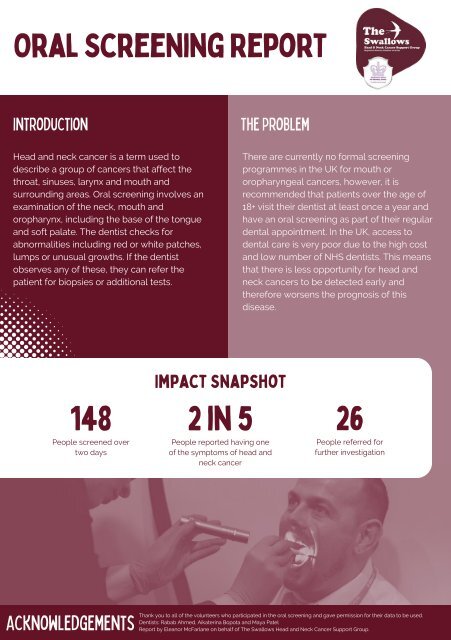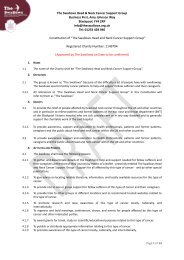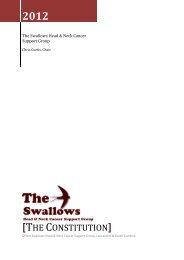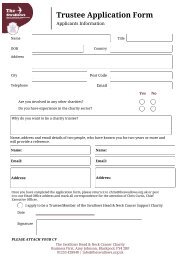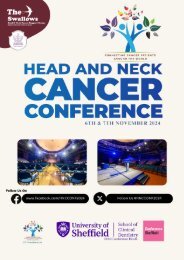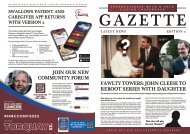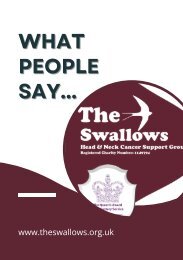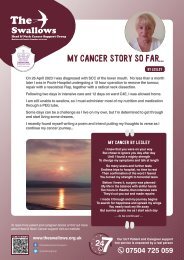Oral Screening Report
Oral screening at the 2023 Oncology Conference in London
Oral screening at the 2023 Oncology Conference in London
Create successful ePaper yourself
Turn your PDF publications into a flip-book with our unique Google optimized e-Paper software.
<strong>Oral</strong> <strong>Screening</strong> <strong>Report</strong><br />
Introduction<br />
Head and neck cancer is a term used to<br />
describe a group of cancers that affect the<br />
throat, sinuses, larynx and mouth and<br />
surrounding areas. <strong>Oral</strong> screening involves an<br />
examination of the neck, mouth and<br />
oropharynx, including the base of the tongue<br />
and soft palate. The dentist checks for<br />
abnormalities including red or white patches,<br />
lumps or unusual growths. If the dentist<br />
observes any of these, they can refer the<br />
patient for biopsies or additional tests.<br />
The Problem<br />
There are currently no formal screening<br />
programmes in the UK for mouth or<br />
oropharyngeal cancers, however, it is<br />
recommended that patients over the age of<br />
18+ visit their dentist at least once a year and<br />
have an oral screening as part of their regular<br />
dental appointment. In the UK, access to<br />
dental care is very poor due to the high cost<br />
and low number of NHS dentists. This means<br />
that there is less opportunity for head and<br />
neck cancers to be detected early and<br />
therefore worsens the prognosis of this<br />
disease.<br />
148<br />
People screened over<br />
two days<br />
Impact Snapshot<br />
2 in 5<br />
People reported having one<br />
of the symptoms of head and<br />
neck cancer<br />
26<br />
People referred for<br />
further investigation<br />
Acknowledgements<br />
Thank you to all of the volunteers who participated in the oral screening and gave permission for their data to be used.<br />
Dentists: Rabab Ahmed, Aikaterina Bopota and Maya Patel<br />
<strong>Report</strong> by Eleanor McFarlane on behalf of The Swallows Head and Neck Cancer Support Group.
<strong>Oral</strong> <strong>Screening</strong> <strong>Report</strong><br />
Methodology<br />
Methodology<br />
148 volunteers were screened across two days at the Oncology Care Conference 2023 in<br />
London using the <strong>Oral</strong>ID device (Forward Science). This device aids visualisation of<br />
abnormalities of the oral mucosal such as cancer and pre-cancer by using fluorescence<br />
technology. The blue light is at a wavelength of 435–460 nm, allowing it to fluoresce green<br />
when shining on healthy tissue. When shining on abnormal tissue, the abnormality appears<br />
dark blue due to to a lack of fluorescent activity. This allows the clinician to observe<br />
abnormalities that may have otherwise been missed.<br />
Symptoms and risk factors for disease<br />
Prior to examination, volunteers were asked to complete a survey to identify their risk of oral<br />
cancers and whether they are experiencing any symptoms. This asked about their demographic<br />
(male or female); lifestyle choices such as whether the patient smoked, drank alcohol, or used<br />
chewing tobacco, Supari or Paan; and whether they experienced any symptoms of head and<br />
neck cancers or had a family history of these diseases. The survey also asked patients to input<br />
when they had last visited their GP and dentist and whether they attend regular visits to these<br />
healthcare professionals.<br />
<strong>Report</strong> of Day 1 Findings<br />
The morning of Day 2 of the conference saw The Swallows CEO, Chris<br />
Curtis, give a presentation entitled '<strong>Oral</strong> screening in the fight against<br />
Head and Neck Cancer'. During this presentation, the statistics from the<br />
Day 1 activities of oral screening were presented and the audience was<br />
encouraged to go and be screened themselves.
Results and Findings<br />
Demographics<br />
Despite the fact that head and neck cancers disproportionately<br />
1<br />
affect males (71% cases male, 29% cases female ), only 18% of<br />
people who volunteered themselves for an oral screening<br />
were male.<br />
Male<br />
18%<br />
Further research into whether this reluctance to come forward<br />
for screenings is observed in dentists and across the general<br />
public is important as it will inform awareness campaigns. The<br />
male demographic should be targeted in campaigns<br />
encouraging people to get oral cancer screenings due to the<br />
disproportionate effects of this disease based on sex.<br />
Female<br />
82%<br />
Symptoms<br />
Prior to the screening, 2 in 5 people reported to be experiencing one of the listed symptoms.<br />
Lump in the<br />
neck<br />
4%<br />
Bleeding (mouth,<br />
nose, ear)<br />
7%<br />
Risk Factors<br />
Paan, Supari and CHewing Tobacco<br />
Just one volunteer said that<br />
they had tried Paan and Supari<br />
(less than 1% of volunteers)<br />
Change in VOice<br />
(hoarseness)<br />
Tooth or Gum<br />
Problems<br />
Ear ache or<br />
sore throat<br />
Sore or Ulcer in<br />
the mouth<br />
Red or white patch in<br />
the mouth<br />
3% 18% 7% 7%<br />
2%<br />
The survey that volunteers took before their screening also asked about their lifestyle habits<br />
and family history of disease which are risk factors for head and neck cancers. 8% of people<br />
said they had a family history of head and neck cancers (including oral cancer).<br />
Answered Yes<br />
Answered No<br />
Ye<br />
Regularly attend a<br />
GP<br />
SMoking Alcohol Regularly attend a<br />
dentist<br />
Despite 70% of people saying they regularly attended a dentist, only 52% of people reported<br />
visiting their dentist in the last year.<br />
1. cancerresearchuk.org
Results and Findings<br />
(continued)<br />
26<br />
These<br />
people were referred to the NHS/dentist/GP for further investigation based on the<br />
results of their screening<br />
all have the potential to be cases of oral cancers. Early diagnosis is crucial<br />
for head and neck cancers, including oral cancers and so oral screening saves<br />
lives.<br />
Case Study 1<br />
On day 2 of the conference, a female<br />
reporting having a lump in her neck and<br />
ulcers in her mouth, volunteered for an oral<br />
screening. Upon examination, the dentists<br />
made an NHS referral for further<br />
investigation. She reported none of the risk<br />
factors for head and neck cancer in the<br />
survey and had last visited her dentist 6<br />
months prior.<br />
Example picture (not actual pateint data)<br />
Dentists' Comments<br />
Lump in the left neck - Post vascular region (non tender & non mobile). Advised referral to<br />
GP for a hospital Ultrasound scan and investigation<br />
Case Study 2<br />
On day 1 of the conference, a female reporting having no symptoms<br />
was found by the dentists to have a traumatic lesion on the left side of<br />
her mouth. When asked, she said that this lesion will not go away and<br />
was therefore referred to her GP for further investigation.<br />
Reflections<br />
In the UK, access to dental services is limited which prevents early recognition<br />
and diagnosis of head and neck cancers, particularly oral cancers. 148 people<br />
participated in a free oral screening service and 26 of those people were referred<br />
for further investigation which could be life saving.<br />
info@theswallows.org.uk<br />
www.theswallows.org.uk


